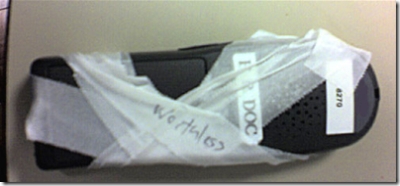…occasionally even if you don’t want them.
We recently beta-tested some new phones for the ED (and again they didn’t work out as promised). We tested two different models, and one was clearly better than the other. How much better?
And there it sat, in the Doc’s room, for the rest of the trial. (We all agreed with the assessment).
Does anyone have an actual workable, reliable in-ED communication system? We’ve tried Nextel: their radio feature is okay, but we/they cannot get the phones to work indoors (despite miles of wire, specialized antennas, and every level of tech help they were able to offer). We looked at Vocera, but were scared off by a) concerns about background noise interfering with their function and b) their reported initial price quote.
Our ED seems to be a comm black hole.





Is this for “Dr. Smithe, line one” or “Dr. Smithe, you’re needed in room 2” type stuff?
We have an overhead system with a backup system of yelling.
I spent some time in an ED that used pagers with text messaging. It seemed to work well. It could be put on vibrate. The doc could read it and decide if it was important enough to interrupt an exam.
Of course, it’s dependent upon the unit clerk putting in a decent message rather than “Front desk needs you”. And it’s not a 2-way communication system.
The problem with vibrating pagers is mine are always carefully timed to go off during pelvic exams and sterile procedures.
The nurses on our unit use SpectraLink phones. It’s nice to be tracked down when needed, but it’s a pain in the ass to get called all the damn time (which is what it feels like most days). Sort of the trade-off, really; you think “oh, i’ll just call ______ and ask this quick question” but then it drives you crazy to get called all the time.
Anyway. The SpectraLinks seem to work well for us in terms of connectivity/signal, and the only real problem we have is battery-related. We also have locator badges that link up to wall mounts and a program at the secretary’s desk; each person’s badge is personalized, and it means that someone can look on the US’s computer or a wall mount and find which room we’re in, even if we’re off the unit. All of this is wired on the floor; we have little radio antennas on the ceiling. And it was probably fairly expensive to install.
How about a blackberry?
At the hospital that I work at they use SpectraLink phones. They still get killed though. Mostly due to dropping and fluid. They hold up OK. More get lost than broken.
My hospital is getting ready to trial a VoIP system from CISCO systems. We are setting it up as a research project to see if the comm systems actually increase time to consult and patient dispo. We wanted Vocera as well, but what a cost!
University of Nebraska Medical Center in Omaha has a cell phone-like system. In the limited time I’ve been there for clinicals the system seems to work rather smoothly…
According to my computer geek, we need to look at a SIP system. With Wi-Fi this system would allow secure communication as well as the capability of dialing into the phone system.
Nortel, Cisco, and Avaya all have this type of system out to the consumer.
I can’t remember the brand of the system we used at my last ER, but it entailed wearing the walkie-talkie unit on your belt– which was hooked to an ear-piece with a boom microphone. The whole thing was a pain in the butt because it took 5 minutes to take it all off to go to the bathroom—and you had to listen to everybody’s conversation besides your own. None of us were very compliant.
We used a SpectraLink system during residency at a busy level 1 trauma center with all the requisite steel, concrete and electronics everywhere. The major downside was the very reason we carried them: we could be called anywhere anytime, whether in the bathroom doing a pelvic or in the middle of an intubation. That being said in a big department it did help when managing consultants, taking stat radiology reads and getting ahold of nurses etc.
Good luck
Dr. G. You do your pelvic’s in the bathroom?
We tried Vocera in our Level I ED and it was a total flop. The voice recognition was horrible, they got lost easily, the batteries died quickly, and everyone hated them. We’re now back to nextel phones.
(That’s a vocera in your pic, isn’t it??)
The one in our hospital seems to work well, judging from the absence of cursing, and we have some REAL dead spots. I’ll try to find out the company. The ED docs use it, anesthesiologists, and they’re roaming around the hospital quite a bit.
The bottom line anyway is getting it specifically stated in the contract that the company has X amount of time to figure out and correct reception issues, or they get their equipment back and you get your money back. If they won’t agree, you show them the door.
I used to work on the cisco phones. I have no idea if they really work in an ER, but it certainly was one of the places we heard they should be useful and kept it in mind in development.
Our docs are (or think they are) addicted to the Nextel radio function, wherein we can be called from one phone in a radio fashion. The system we were trying out was a Spectralink, but with a radio function.
Unfortunately, the radio part is for ‘all call’ only, so the radio part calls everyone. So, the audio quality was good, but the newer of the two designs they brought wwere not up to the drill, frankly, hence the tape job.
Steve beat me to it — VoIP (maybe in combination with Bluetooth) seems like a sensible solution, although I don’t know what’s out there in the way of commercial applications.